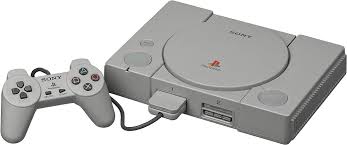
Released in 1994, the Sony PlayStation, commonly known as the PS1, marked Sony’s bold entry into the gaming world and forever changed the landscape of home consoles. The PS1 featured a compact, gray design that was simple yet striking for its time. With its top-loading disc tray and distinctive circular buttons, it set itself apart from the cartridge-based systems of its competitors.
The PS1’s build quality was solid for its era, with durable plastic housing and reliable internals that could withstand hours of gaming. However, the disc tray mechanism was known to be a bit delicate, and some units faced issues with reading discs after extended use. The console’s relatively small size made it easy to place in any setup, and its understated design ensured it never looked out of place.
The PS1 was a technical marvel in the mid-90s, sporting a 32-bit RISC CPU and an impressive 3D-capable graphics engine. It was the first console to use CD-ROMs as its primary media format, allowing developers to include larger game worlds, full-motion video, and CD-quality audio. This gave the PS1 a significant advantage over competitors still relying on cartridges.
The PS1 delivered groundbreaking performance with real-time 3D graphics, which were a huge leap from the 2D sprite-based games that dominated earlier consoles. Its ability to render complex 3D environments, along with its CD-quality sound, provided an immersive gaming experience that was unmatched at the time. However, games often featured low polygon counts and basic textures, which are quite dated by today’s standards.
The PS1 initially launched with the standard PlayStation controller, which was later replaced by the revolutionary DualShock controller. The DualShock introduced twin analog sticks and built-in rumble feedback, significantly enhancing the gaming experience by providing better control and physical feedback during gameplay. This controller design set the standard for future PlayStation controllers.
The PS1’s user interface was straightforward, featuring a basic boot-up screen that allowed players to manage memory cards or play CDs. While minimal by today’s standards, it was intuitive and functional, focusing purely on getting players into the game with minimal distractions. The familiar startup sound and visual sequence became iconic, instantly recognizable to millions of gamers.
The PS1 boasts one of the most influential game libraries in gaming history, featuring legendary franchises and iconic titles that have stood the test of time. With over 7,000 games released, players enjoyed classics like “Final Fantasy VII,” “Metal Gear Solid,” “Crash Bandicoot,” “Gran Turismo,” and “Resident Evil.” The vast array of genres and the quality of its exclusives helped cement the PS1’s legacy.
The PS1’s exclusives defined the platform, with many franchises making their debut on the system. From epic RPGs to genre-defining action-adventures, the PS1 delivered some of the most memorable gaming experiences of all time, setting the standard for future PlayStation consoles.
While primarily a gaming console, the PS1 also supported CD playback, allowing users to listen to music directly through their console. This was a nice bonus feature for the time, making it a multifunctional device in an era when most other consoles were purely for gaming.
The PS1 was known for its relatively quiet operation, especially compared to later consoles. Its small form factor and low power consumption made it an efficient and discreet addition to any entertainment setup. However, over time, some units developed disc drive noise, particularly when playing games with heavy load times.
The PS1 was highly energy-efficient, consuming very little power during gameplay and idle states. Its low heat output made it reliable during long gaming sessions without worrying about overheating.
The PS1 relied on memory cards for game saves, which were revolutionary at the time but limited by today’s standards. Each memory card held 1MB of data, which was usually enough for several game saves but could become restrictive for avid gamers. Expansion options were minimal, focusing primarily on add-ons like the Multitap for additional controller support.
The original Sony PlayStation was a groundbreaking console that set the stage for modern gaming. With its revolutionary 3D graphics, CD-ROM capabilities, and a legendary library of games, the PS1 remains one of the most influential consoles in gaming history. It brought gaming to a wider audience and introduced franchises that continue to thrive today. Despite its age, the PS1’s legacy lives on through its impact on the industry and the unforgettable experiences it provided to millions of gamers worldwide.
Overall, the PS1 is a classic that helped shape the gaming industry as we know it. It remains a nostalgic and beloved piece of gaming history, and its impact is still felt in the gaming world today.






